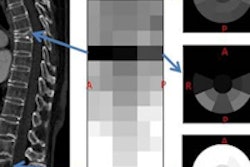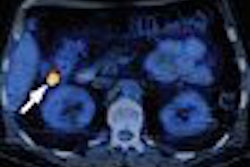More than a third of patients with diagnosed cervical spine injuries (CSI) had secondary injuries that were missed on x-ray, researchers in California have reported. The study, published online in the September 5 Annals of Emergency Medicine, underscores the need for CT and perhaps other imaging modalities when evaluating trauma patients.
The retrospective review from the University of California, Los Angeles, isn't the first to cast a jaundiced eye on the use of radiography as the sole imaging modality in suspected cervical spine patients. A number of studies, such as a Swiss trial published two years ago in Radiology, have noted x-ray's limitations in finding potentially significant fractures and clinically important secondary injuries.
"On the other hand, prominent emergency radiology literature states that CT imaging is not required in the evaluation of patients whose plain films show ... specific injuries ('index CSI')," wrote Dr. Tyler Barrett, Dr. William Mower, and colleagues from the UCLA Emergency Medical Center. Thus, the question posed by the study was whether CT is unnecessary in CSI patients in whom an injury had already been identified on x-ray.
"We sought to evaluate this recommendation by examining how frequently patients with these index CSI have additional secondary injuries," they wrote (Annals of Emergency Medicine, September 5, 2005).
Data for the retrospective review was culled from the multicenter National Emergency X-Radiography Utilization Study (NEXUS), which enrolled 34,609 subjects from 21 centers who had sustained blunt trauma. Of these patients, 818 had sustained a total of 1,496 CSI, which were identified by radiography in 224 patients.
Barrett's team reviewed the data from these 224 patients, looking for additional secondary CSI that weren't identified on radiography but could be seen on CT scans of the same patient acquired during the course of care.
"We defined clinically significant injuries prior to data collection, using prespecified criteria developed by an expert panel for the main NEXUS study," the team noted.
Of the 818 patients who sustained 1,496 injuries (indexed in the chart below), only 224/818 (27.4%) of the patients were identified on the x-rays, the results showed. These 818 patients had a total of 424 distinct injuries, including 297 specified on the index of relevant CSI. The injuries were isolated in 114 cases (50.9%; 95% CI: 44.1-57.6) and represented multiple CSI in 110 cases (49%; 95% CI: 42.4-55.9).
"Plain radiographs failed to detect at least one injury in 81 of the 110 patients with multiple injuries (73.6%; 95% CI: 64.4-81.6), or 36.2% of the 224 patients with index CSI (95% CI: 29.9-42.8)," the authors noted. "Overall, plain radiographs failed to detect 101 of the 310 injuries present in multiply injured patients (32.6%; 95% CI: 27.4-38.1)."
Just 21/101 of the missed injuries were deemed clinically insignificant. A noncontiguous CSI was found on either CT or plain film in 22/110 patients with multiple injuries.
|
||||||||||||||||||||||||||||||||||||||||||||
| Data from the online Annals of Emergency Medicine, September 5, 2005, shows that radiography missed significant injuries of the cervical spine that were visualized on CT. |
The true number of injuries missed on radiography was likely higher than the total recorded, the team noted. Also, the results assumed the assumption that all radiographs were all technically adequate, which is unlikely in light of the real-world environment in which they were acquired. Finally, the group noted that injuries missed on radiography were concentrated in the pedicles and lateral masses of the cervical spine, which are particularly difficult to visualize on plain radiography.
Most of the injuries, "including dense fractures and vertebral body fractures, are clinically important, and require specific directed intervention, such that failure to detect them could have devastating consequences," the authors wrote. Because patients often sustain multiple forces during the trauma, the visualization of injury associated with a specific mechanical force doesn't preclude the existence of injuries associated with other forces, they added.
"While it is unclear exactly which patients require CT imaging, we believe that patients with any plain film evidence of CSI, including those with the index CSI previously considered to be at low risk for secondary injuries, should undergo CT imaging of the entire cervical spine, both to determine whether secondary injuries are present, and to identify those noncontiguous injuries that in fact occur in a substantial number of cases," Barrett and colleagues concluded.
By Eric Barnes
AuntMinnie.com staff writer
September 14, 2005
Related Reading
Study reconfirms that MDCT can replace c-spine x-rays, February 25, 2005
CT: An all-star modality for C-spine trauma? August 18, 2004
Radiographic positioning techniques for the cervical spine, March 26, 2003
Studies and practice shape CT's role in c-spine trauma, August 28, 2001
Copyright © 2005 AuntMinnie.com



















